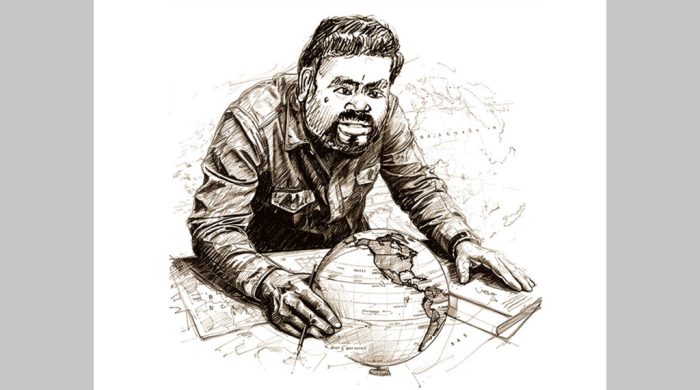US tightens noose around China

- Update Time : Monday, January 17, 2022
- 120 Time View

THE word ‘encirclement’ does not appear in the 2022 National Defence Authorisation Act, signed into law by US president Joe Biden on December 27, or in other recent administration statements about its foreign and military policies. Nor does that classic Cold-War era term ‘containment’ ever come up. Still, top leaders of the United States have reached a consensus on a strategy to encircle and contain the latest great power, China, with hostile military alliances, thereby thwarting its rise to full superpower status.
The gigantic 2022 defence bill — passed with overwhelming support from both parties — provides a detailed blueprint for surrounding China with a potentially suffocating network of US bases, military forces, and increasingly militarised partner states. The goal is to enable Washington to barricade that country’s military inside its own territory and potentially cripple its economy in any future crisis. For China’s leaders, who surely can’t tolerate being encircled in such a fashion, it’s an open invitation to… well, there’s no point in not being blunt… fight their way out of confinement.
Like every ‘defence’ bill before it, the $768 billion 2022 NDAA is replete with all-too-generous handouts to military contractors for favoured Pentagon weaponry. That would include F-35 jet fighters, Virginia-class submarines, Arleigh Burke-class destroyers, and a wide assortment of guided missiles. But as the Senate Armed Services Committee noted in a summary of the bill, it also incorporates an array of targeted appropriations and policy initiatives aimed at encircling, containing, and someday potentially overpowering China. Among these are an extra $7.1 billion for the Pacific Deterrence Initiative, or the PDI, a programme initiated last year with the aim of bolstering US and allied forces in the Pacific.
Nor are these just isolated items in that 2,186-page bill. The authorisation act includes a ‘sense of Congress’ measure focused on ‘defence alliances and partnerships in the Indo-Pacific region,’ providing a conceptual blueprint for such an encirclement strategy. Under it, the secretary of defence is enjoined to ‘strengthen United States defence alliances and partnerships in the Indo-Pacific region so as to further the comparative advantage of the United States in strategic competition with the People’s Republic of China.’
That the 2022 National Defence Authorisation Act passed with no significant opposition in the House or Senate suggests that support for these and similar measures is strong in both parties. Some progressive Democrats had indeed sought to reduce the size of military spending, but their colleagues on the House and Senate Armed Services Committees instead voted to increase this year’s already staggering allotment for the Pentagon by another $24 billion — specifically to better contain, or fight, China. Most of those added taxpayer dollars will go towards the creation of hypersonic missiles and other advanced weaponry aimed at the PRC, and increased military exercises and security cooperation with US allies in the region.
For Chinese leaders, there can be no doubt about the meaning of all this: whatever Washington might say about peaceful competition, the Biden administration, like the Trump administration before it, has no intention of allowing the PRC to achieve parity with the United States on the world stage. In fact, it is prepared to employ every means, including military force, to prevent that from happening. This leaves Beijing with two choices: succumb to US pressure and accept second-class status in world affairs or challenge Washington’s strategy of containment. It’s hard to imagine that country’s current leadership accepting the first choice, while the second, were it adopted, would surely lead, sooner or later, to armed conflict.
Enduring lure of encirclement
THE notion of surrounding China with a chain of hostile powers was, in fact, first promoted as official policy in the early months of president George W Bush’s administration. At that time, vice-president Dick Cheney and national security advisor Condoleezza Rice went to work establishing an anti-China alliance system in Asia, following guidelines laid out by Rice in a January 2000 article in Foreign Affairs. There, she warned of Beijing’s efforts to ‘alter Asia’s balance of power in its own favour’ — a drive the US must respond to by deepening ‘its cooperation with Japan and South Korea’ and by ‘maintaining its commitment to a robust military presence in the region.’ It should, she further indicated, ‘pay closer attention to India’s role in the regional balance.’
This has, in fact, remained part of the governing US global playbook ever since, even if, for the Bush team, its implementation came to an abrupt halt on September 11, 2001, when Islamic militants attacked the Twin Towers in New York City and the Pentagon in Washington, DC, leading the administration to declare a ‘global war on terror.’
Only a decade later, in 2011, did official Washington return to the Rice-Cheney strategy of encircling China and blunting or suppressing its growing power. That November, in an address to the Australian Parliament, president Obama announced an American ‘pivot to Asia’ — a drive to restore Washington’s dominance in the region, while enlisting its allies there in an intensifying effort to contain China. ‘As president, I have… made a deliberate and strategic decision,’ Obama declared in Canberra. ‘As a Pacific nation, the United States will play a larger and long-term role in shaping this region and its future. As we end today’s wars in the Middle East, I have directed my national security team to make our presence and mission in the Asia Pacific a top priority.’
Like the Bush team before it, however, the Obama administration was blindsided by events in the Middle East, specifically the 2014 takeover of significant parts of Iraq and Syria by the Islamic State, and so was forced to suspend its focus on the Pacific. Only in the final years of the Trump administration did the idea of encircling China once again achieve pre-eminence in US strategic thinking.
Led by secretary of state Mike Pompeo, the Trump effort proved far more substantial, involving as it did the beefing-up of US forces in the Pacific; closer military ties with Australia, Japan, and South Korea; and an intensified outreach to India. Pompeo also added several new features to the mix: a ‘quadrilateral’ alliance between Australia, India, Japan, and the United States, dubbed the Quad, for short; increased diplomatic ties with Taiwan; and the explicit demonisation of China as an enemy of western values.
In a July 2020 speech at the Richard Nixon Presidential Library, Pompeo laid out the new China policy vividly. To prevent the Chinese Communist Party from demolishing ‘the rules-based order that our societies have worked so hard to build,’ he declared, we must ‘draw common lines in the sand that cannot be washed away by the CCP’s bargains or their blandishments.’ This required not only bolstering US forces in Asia but also creating a NATO-like alliance system to curb China’s further growth.
Pompeo also launched two key anti-China initiatives: the institutionalisation of the Quadrilateral Security Dialogue and the expansion of diplomatic and military relations with Taiwan. The Quad had initially been formed in 2007 by Japanese prime minister Shinzo Abe, with the support of vice-president Dick Cheney and the leaders of Australia and India, but fell into abeyance for years. It was revived, however, in 2017 when Australian prime minister Malcolm Turnbull joined Abe, Indian prime minister Narendra Modi, and Donald Trump in promoting a stepped-up effort to contain China.
As for Taiwan, Pompeo upped the ante there by approving diplomatic missions to its capital, Taipei, by senior officials, including health secretary Alex Azar and undersecretary of state Keith Krach, the highest-ranking members of any administration to visit the island since 1979, when Washington severed formal relations with its government. Both visits were roundly criticised by Chinese officials as serious violations of the commitments Washington had made to Beijing under the agreement establishing ties with the PRC.
Biden adopts encirclement agenda
ON ENTERING the White House, president Biden promised to reverse many of the unpopular policies of his predecessor, but strategy towards China was not among them. Indeed, his administration has embraced the Pompeo encirclement agenda with a vengeance. As a result, ominously enough, preparations for a possible war with China are now the Pentagon’s top priority as, for the state department, is the further isolation of Beijing diplomatically.
In line with that outlook, the defence department’s 2022 budget request asserted that ‘China poses the greatest long-term challenge to the United States’ and, accordingly, that ‘the department will prioritise China as our number one pacing challenge and develop the right operational concepts, capabilities, and plans to bolster deterrence and maintain our competitive advantage.’
In the meantime, as its key instrument for bolstering ties with allies in the Asia-Pacific region, the Biden administration endorsed Trump’s Pacific Deterrence Initiative. Proposed PDI spending was increased by 132 per cent in the Pentagon’s 2022 budget request, rising to $5.1 billion from the $2.2 billion in 2021. And if you want a measure of this moment in relation to China, consider this: even that increase was deemed insufficient by congressional Democrats and Republicans who added another $2 billion to the PDI allocation for 2022.
To further demonstrate Washington’s commitment to an anti-China alliance in Asia, the first two heads of state invited to the White House to meet president Biden were Japanese prime minister Yoshi Suga and South Korean president Moon Jae-in. In talks with them, Biden emphasised the importance of joint efforts to counter Beijing. Following his meeting with Suga, for instance, Biden publicly insisted that his administration was ‘committed to working together to take on the challenges from China… to ensure a future of a free and open Indo-Pacific.’
On September 24, in a first, leaders of the Quad all met with Biden at a White House ‘summit.’ Although the administration emphasised non-military initiatives in its post-summit official report, the main order of business was clearly to strengthen military cooperation in the region. As if to underscore this, Biden used the occasion to highlight an agreement he’d just signed with prime minister Scott Morrison of Australia to provide that country with the propulsion technology for a new fleet of nuclear-powered submarines — a move obviously aimed at China. And note as well that, just days before the summit, the administration formed a new alliance with Australia and the United Kingdom, called AUKUS, and again aimed at China.
Finally, Biden has continued to increase diplomatic and military contacts with Taiwan, beginning on his first day in office when Hsiao Bi-khim, Taipei’s de facto ambassador to Washington, attended his inauguration. ‘President Biden will stand with friends and allies to advance our shared prosperity, security, and values in the Asia-Pacific region — and that includes Taiwan,’ a top administration official said at the time. Other high-level contacts with Taiwanese officials, including military personnel, soon followed.
‘Grand strategy’ for containment
WHAT all these initiatives have lacked, until now, is an overarching plan for curbing China’s rise and so ensuring the US’s permanent supremacy in the Indo-Pacific region. The authors of this year’s NDAA were remarkably focused on this deficiency and several provisions of the bill are designed to provide just such a master plan. These include a series of measures intended to incorporate Taiwan into the US defence system surrounding China and a requirement for the drafting of a comprehensive ‘grand strategy’ for containing that country on every front.
A ‘sense of Congress’ measure in that bill provides overarching guidance on these disparate initiatives, stipulating an unbroken chain of US-armed sentinel states — stretching from Japan and South Korea in the northern Pacific to Australia, the Philippines, Thailand, and Singapore in the south and India on China’s eastern flank — meant to encircle and contain the People’s Republic. Ominously enough, Taiwan, too, is included in the projected anti-China network.
That island’s imagined future role in such an emerging strategic plan was further spelled out in a provision entitled ‘Sense of Congress on Taiwan Defence Relations.’ Essentially, this measure insists that Washington’s 1978 pledge to terminate its military ties with Taipei and a subsequent 1982 US-China agreement committing this country to reduce the quality and quantity of its arms transfers to Taiwan are no longer valid due to China’s ‘increasingly coercive and aggressive behaviour’ towards the island. Accordingly, the measure advocates closer military coordination between the two countries and the sale of increasingly sophisticated weapons systems to Taiwan, along with the technology to manufacture some of them.
Add all this up and here’s the new reality of the Biden years: the disputed island of Taiwan, just off the Chinese mainland and claimed as a province by the PRC, is now being converted into a de facto military ally of the United States. There could hardly be a more direct assault on China’s bottom line: that, sooner or later, the island must agree to peacefully reunite with the mainland or face military action.
Recognising that the policies spelled out in the 2022 NDAA represent a fundamental threat to China’s security and its desire for a greater international role, Congress also directed the president to come up with a ‘grand strategy’ on US-China relations in the next nine months. This should include an assessment of that country’s global objectives and an inventory of the economic, diplomatic, and military capabilities the US will require to blunt its rise. In addition, it calls on the Biden administration to examine ‘the assumptions and end-state or end states of the strategy of the United States globally and in the Indo-Pacific region with respect to the People’s Republic of China.’ No explanation is given for the meaning of ‘end-state or end states,’ but it’s easy to imagine that the authors of that measure had in mind the potential collapse of the Chinese Communist government or some form of war between the two countries.
How will Chinese leaders react to all this? No one yet knows, but president Xi Jinping provided at least a glimpse of what that response might be in a July 1 address marking the 100th anniversary of the founding of the Chinese Communist Party. ‘We will never allow any foreign force to bully, oppress, or subjugate us,’ he declared, as China’s newest tanks, rockets, and missiles rolled by. ‘Anyone who would attempt to do so will find themselves on a collision course with a great wall of steel forged by over 1.4 billion Chinese people.’
Welcome to the new 21st-century cold war on a planet desperately in need of something else.
Consortiumnews.com, January 13. Michael T Klare is the five-college professor emeritus of peace and world security studies at Hampshire College and senior visiting fellow at the Arms Control Association. He is a founder of the Committee for a Sane US-China Policy.



















